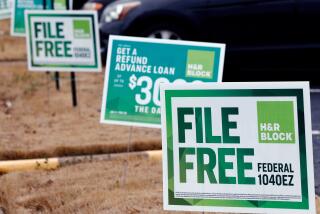IRS Says It Was Too Taxing to Decipher Form
- Share via
Good news for the self-employed: It may not be so terrible this year to fill out Internal Revenue Service reports on a Keogh plan. That’s because all the taxpayers who weren’t driven to hang themselves last year over the forms complained all the way to Washington, and the reporting requirements were eased. Somewhat.
A so-called Keogh Plan (after the former New York Representative Eugene Keogh who first proposed it) allows people with self-employment income to defer taxes on some of it--essentially a pension plan. Each year they can deduct a certain contribution--for the most commonly sold plans, up to $30,000 or 15% of earned income, whichever is less--and pay no taxes on it until they start to withdraw it at age 59 1/2.
Keogh plans have been around since 1962’s Tax Retirement Act. What’s new is the reporting requirement--or at least the current reporting requirement. Tax reforms in 1974 made Keogh holders file a report in 1977 for 1976 plan years, but not again until 1982, when that year’s tax reforms established the current filing requirements, starting with 1984 plan years.
“The law was changed to treat all pension plans the same, and the filing requirements are just one part of that,” says Robert Giannangeli, IRS spokesman in Los Angeles. As a result, about 500,000 to 600,000 individuals with little one-participant plans (one-third of all Keoghs) had to fill out the same form required of businesses with 100 employee-participants. Many had never filed before, some hadn’t made a contribution in years, and lots had simply put their Keogh money into local financial institutions, essentially savings accounts they never touched and certainly never questioned.
Demanded Details
Suddenly the 5500-C form wanted to know if the money was invested in a fixed-benefit, unit-benefit or flat-benefit plan, whether it contained a cash or deferred arrangement as described in tax code section 401(k), and whether it was “integrated with Social Security,” and was maybe a “top-heavy plan within the meaning of code section 416.” Alas, few individuals could even fill in the IRS serial number of the “master” plan they’d bought.
“I have a B.A. in English from UCLA and a master’s from Northern Arizona University,” Orange County stockbroker Mike Lindsay wrote the IRS. “Furthermore, I’ve been a stockbroker for nine years, I read business accounting statements all the time, and I sell Keoghs. If I can’t decipher what it is you want on this form, who can?”
No one, apparently. The IRS postponed the 1985 filing deadline from July 31 to Sept 31 because, Giannangeli says, “there was a lack of knowledge about the filing requirements.” Unwilling to involve their tax preparers out of season, people called their Keogh trustees, who invariably referred them to their tax preparers. “We didn’t realize what a need there was,” says Cheryl Aronoff, vice president at California Federal Savings & Loan. “We were accustomed to working with people’s accountants or advisers.”
Desperate, some people copied all the printed matter their trustees had given them and sent it in, leaving the IRS to decide for itself whether the plan was “profit-sharing” or “money purchase.” Some tried to use information from the overall trust reports available, in essence giving the IRS figures for the entire amount in the fund instead of their own small share.
Realized the Problem
When the forms were in--and there was such confusion that some people never filed them at all--the IRS noticed that people “did seem to be struggling,” says Lou Wolff, the senior technician on 5500s at the Fresno Service Center. This was indicated, Wolff says, by “missing line items, sometimes a note saying ‘Please help.’ We saw a lot of question marks, particularly on the plan number.” (This is the number assigned by the plan sponsor to all employee participants, starting with 001. Thus, all single-participant plans are numbered 001. Self-evident, right?)
Such observations, plus the fact, Giannangeli says, that “the screams were apparently heard in Washington,” led to some changes this year. Some Keogh vendors-- California Federal, for one-- now send out instructions for filling out the forms, mindlessly (Ex.-- “2(a),(b),(c). Enter ‘Same’ three times.” “6(j). Enter ‘N/A.”’)
The IRS has also changed the requirements: single-participant plan-holders can now file Form 5500-R instead of 5500-C. At two pages, this form is shorter, but it still poses a few stumpers for ordinary people with simple accounts, e.g. “Is this plan covered under the Pension Benefit Guaranty Corporation termination insurance program?” What’s more, it’s possible that taxpayers should also file a so-called Schedule P, which the IRS says is optional. What’s more, its only function is to start the statute of limitations running on the three years during which the IRS can challenge the filing--a good example of the whole Keogh reporting procedure as currently constituted.
Considering New Form
Even the IRS, doubtless anticipating more question marks, is “thinking of a 5500 EZ-- essentially your name and number, basically a registration form,” says IRS Washington spokesman Steve Pyrek. But just in case, many people are considering the option of terminating their Keoghs and rolling the money over into their IRA accounts. “I closed out my Keogh,” says a financial writer with some free-lance income, “because I didn’t want to deal with this every year. I didn’t understand the questions OR the instructions and the amount I put away wasn’t worth it.”
More to Read
Inside the business of entertainment
The Wide Shot brings you news, analysis and insights on everything from streaming wars to production — and what it all means for the future.
You may occasionally receive promotional content from the Los Angeles Times.










